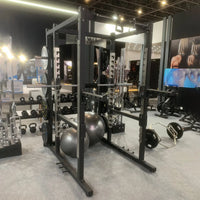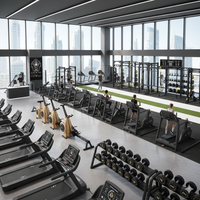In today’s performance-driven fitness world, recovery and mobility are just as important as strength and endurance. Athletes—whether professionals or recreational enthusiasts—are increasingly incorporating Pilates into their training to improve flexibility, balance, and core strength. As a gym owner or manager, adapting your facility with Pilates and mobility training tools can attract a new wave of clientele looking for a more holistic fitness approach.
Equipping your facility with the right commercial gym equipment that supports both performance and recovery can help position your gym as a modern, full-spectrum training center.
1. The Athletic Benefits of Pilates
Pilates isn't just for dancers or rehab patients—it's a powerful discipline that benefits athletes across all sports. Key benefits include:
-
Improved core stability and posture
-
Greater flexibility and joint mobility
-
Reduced risk of injury through balanced muscle development
-
Enhanced muscular control, especially for stabilizer muscles
From runners and swimmers to weightlifters and football players, Pilates provides functional movement training that enhances overall performance.
2. Essential Pilates Equipment for Commercial Gyms
To make your gym athlete-ready, start with Pilates equipment that supports both group classes and individualized training.
✔ Reformer Machines (Commercial-Grade)
-
The gold standard for Pilates.
-
Offers variable resistance through springs for core, legs, and upper body workouts.
-
Supports both mobility and strength training.
-
Choose models with adjustable footbars and headrests for versatility.
✔ Pilates Towers or Cadillac Units
-
Allows for vertical movements, suspension-based training, and spinal mobility work.
-
Great for advanced users and therapeutic exercises.
✔ Pilates Chairs
-
Compact and versatile.
-
Strengthens balance and stability, especially helpful for lower-body rehab.
✔ Pilates Arcs or Spine Correctors
-
Target spinal mobility and posture correction.
-
Ideal for athletes recovering from back or shoulder tightness.
Invest in commercial-grade Pilates machines that can withstand frequent use, especially if you're planning to host instructor-led sessions or recovery classes.
3. Mobility Training Tools That Complement Pilates
Beyond Pilates machines, every modern commercial gym equipment setup should include a range of mobility training tools to support recovery, stretching, and joint health.
🔹 Foam Rollers and Massage Balls
-
Promote myofascial release.
-
Ideal for post-workout cooldowns or pre-workout activation.
🔹 Resistance Bands and Loops
-
Great for mobility drills, dynamic stretching, and rehab.
-
Useful in Pilates-based bodyweight movements.
🔹 Slant Boards and Mobility Platforms
-
Improve ankle mobility and knee tracking—especially helpful for athletes with tight calves or knee pain.
🔹 Stability Balls and BOSU Trainers
-
Enhance core engagement and balance.
-
Can be used in Pilates-inspired routines for added challenge.
By incorporating these tools, your gym not only enhances recovery services but also opens new revenue streams through mobility workshops and recovery classes.
4. Layout Tips for a Pilates and Mobility Zone
Dedicating a section of your gym to Pilates and recovery makes a clear statement: you value longevity, not just PRs.
Here’s how to create a functional space:
-
Use rubber or cork flooring to reduce impact and support safe movement.
-
Install mirrors for form checks during mat Pilates or mobility exercises.
-
Add storage racks for resistance bands, mats, and foam rollers.
-
Create open floor areas for stretching, flow movements, or instructor-led mat sessions.
Make sure to separate the zone slightly from heavy equipment areas to maintain a calm, focused vibe.
5. Marketing the Value to Athletes
To attract athletic clients to your Pilates offering:
-
Promote the benefits of mobility and injury prevention on social media.
-
Partner with sports teams, physiotherapists, or athletic coaches to offer recovery classes.
-
Host “Mobility & Core Week” workshops to introduce Pilates to gym-goers unfamiliar with it.
-
Use testimonials from athletes who improved performance or recovered from injury through your Pilates zone.
This positions your facility as a complete training ecosystem—not just another weights-and-cardio gym.
6. Partner with a Trusted Commercial Gym Equipment Supplier
When outfitting your space, work with a supplier who understands the unique needs of both high-performance training and recovery. Look for:
-
Commercial-grade Pilates equipment
-
Bulk deals on mobility training tools
-
Delivery and installation services
-
Ongoing support and maintenance
Whether you’re upgrading an existing facility or launching a new boutique space, partnering with the right equipment provider ensures long-term success.
Conclusion: The Future of Fitness Is Balanced
In a city like Dubai or any modern fitness hub, the competition among gyms is fierce. Offering Pilates for athletes is more than a trendy add-on—it’s a vital component of performance training. By equipping your gym with the right commercial gym equipment and mobility training tools, you're setting your clients up for success both in and out of competition.
From recovery zones to reformer classes, the integration of Pilates into athletic training is the new gold standard. Don’t get left behind—create a gym environment that supports performance, prevents injury, and builds lasting results.




0 comments